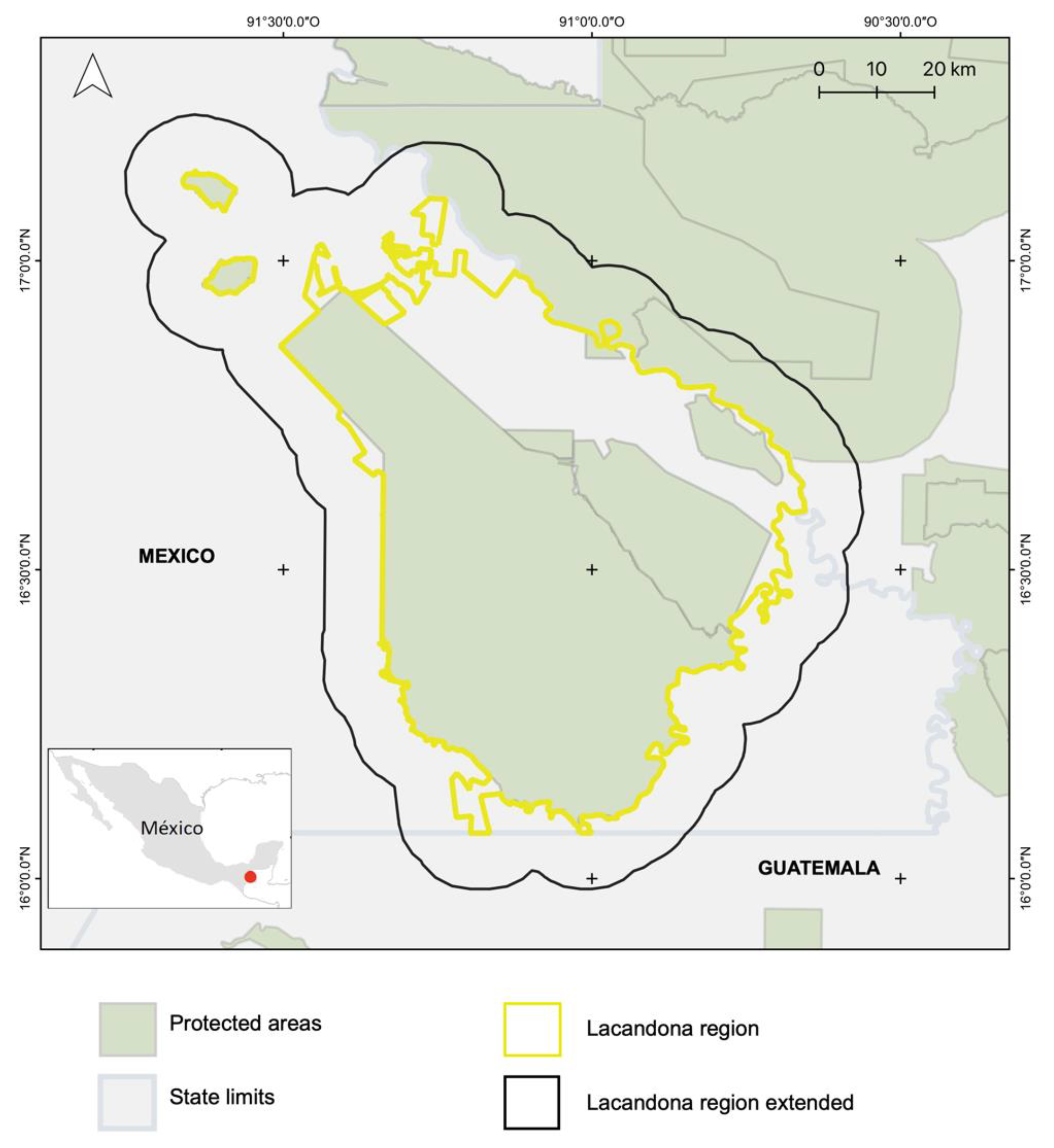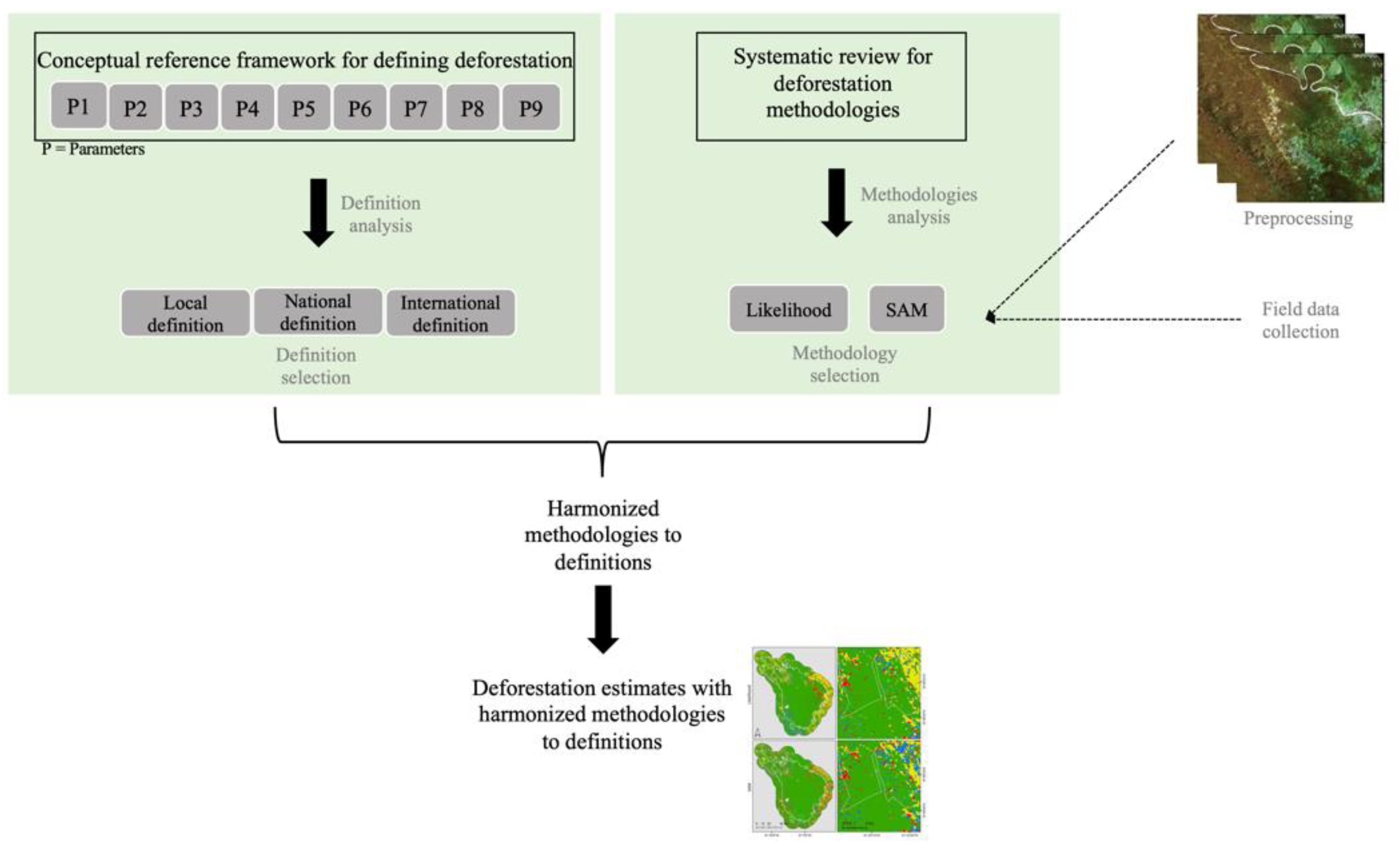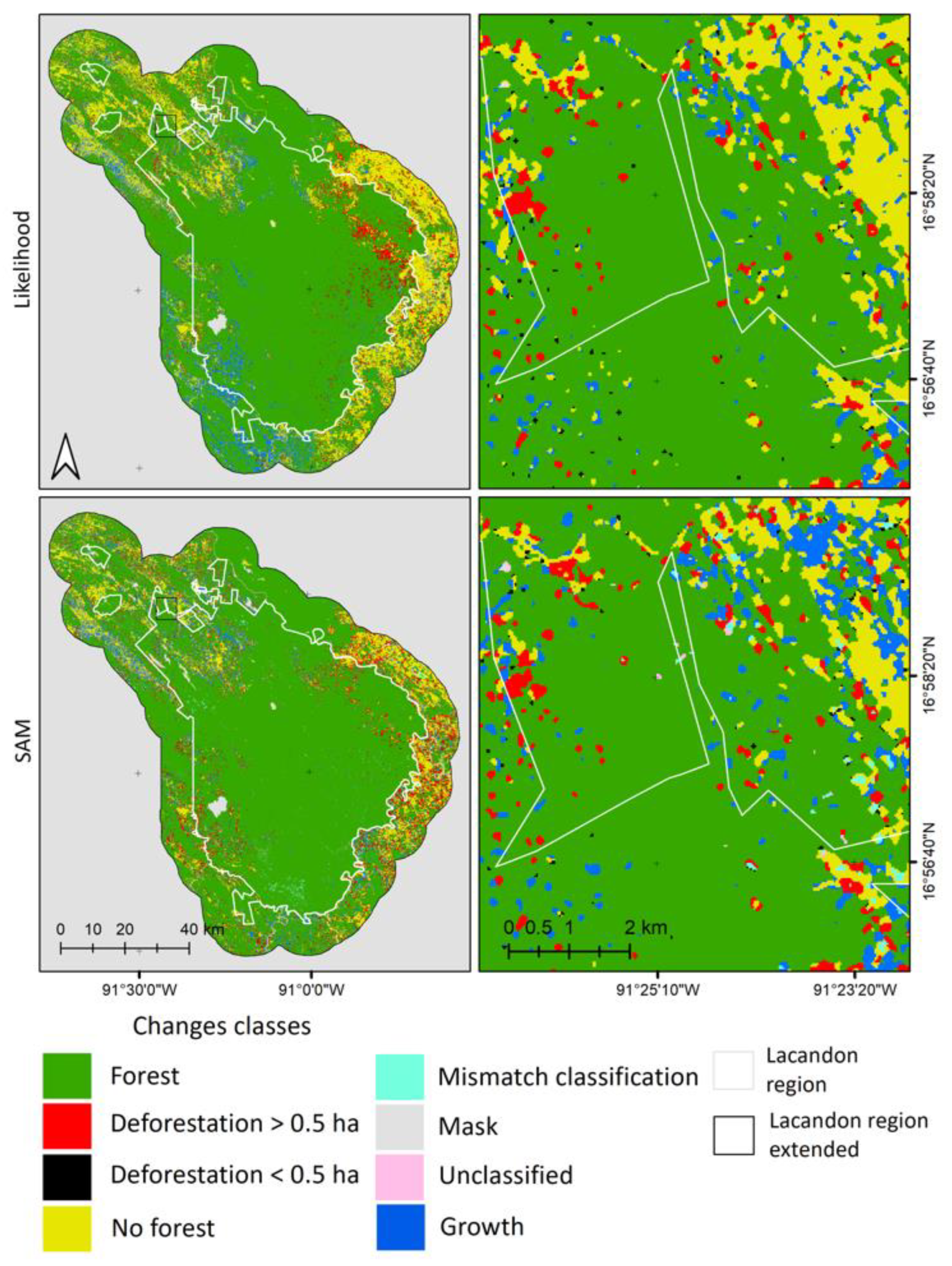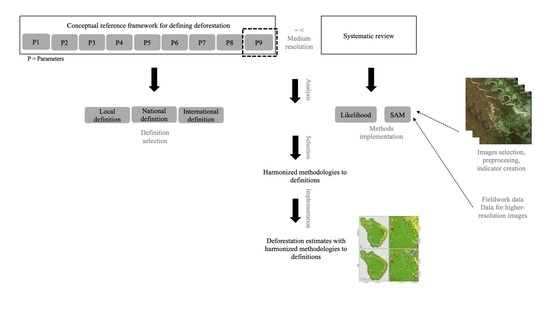Harmonizing Definitions and Methods to Estimate Deforestation at the Lacandona Tropical Region in Southern Mexico
Abstract
:1. Introduction
2. Materials and Methods
2.1. Study Region
2.2. Concepts and Methodologies Harmonized
2.3. Image Processing and Fieldwork
2.4. Imaging Classification and Map Depicting Changes
3. Results
3.1. Towards the Harmonization of Concepts and Methodologies for Deforestation
3.2. Likelihood and SAM Image Classifications
3.3. Deforestation Maps Using Harmonized Methodologies to Their Definitions
4. Discussion
4.1. Particularities of Deforestation Definitions
4.2. Particularities of Classifications
4.3. Objectives, Harmonized Definitions, and Methods
4.4. Assessing the Accuracy of Maps
5. Conclusions
Supplementary Materials
Author Contributions
Funding
Data Availability Statement
Acknowledgments
Conflicts of Interest
Appendix A. Forest and Deforestation Definition
References
- Giam, X. Global biodiversity loss from tropical deforestation. Proc. Natl. Acad. Sci. USA 2017, 114, 5775–5777. [Google Scholar] [CrossRef] [Green Version]
- Allan, J.; Possingham, H.; Venter, O.; Biggs, D.; Watson, J. The Extraordinary Value of Wilderness Areas in the Anthropocene. In Reference Module in Earth Systems and Environmental Sciences. Encyclopedia of the World’s Biomes; Goldstein, M.I., DellaSala, D.A., Eds.; Elsevier: Amsterdam, The Netherlands, 2020; pp. 158–168. [Google Scholar]
- Geist, H.J.; Lambin, E.F. Proximate Causes and Underlying Driving Forces of Tropical Deforestation. BioScience 2002, 52, 143–150. [Google Scholar] [CrossRef]
- Gibson, L.; Lee, T.M.; Koh, L.P.; Brook, B.W.; Gardner, T.A.; Barlow, J.; Peres, C.A.; Bradshaw, C.J.A.; Laurance, W.F.; Lovejoy, T.E.; et al. 2011. Primary forests are irreplaceable for sustaining tropical biodiversity. Nature 2011, 478, 378–381. [Google Scholar] [CrossRef]
- FAO. Global Forest Resources Assessment 2020—Key Findings; Food and Agriculture Organization of the United Nations: Quebec, QC, Canada, 2020. [Google Scholar] [CrossRef]
- Fernández-Montes de Oca, A.I.; Gallardo-Cruz, J.A.; Martínez, M. Deforestación en la región selva lacandona. In Conservación y Desarrollo Sustentable en la Selva Lacandona. 25 años de Actividades y Experiencias; Carabias, J., de la Maza, J., Cadena, R., Eds.; Natura y Ecosistemas Mexicanos AC: Mexico City, Mexico, 2015; pp. 61–68. [Google Scholar]
- GFW. Analysis of Tree Cover Loss. Available online: https://www.globalforestwatch.org/map/ (accessed on 1 February 2020).
- Solórzano, J.V. Identificación y Cuantificación del Cambio de uso de Suelo en las Áreas Naturales Protegidas de la Selva Lacandona y en el Municipio de Marqués de Comillas; Technical Report; Centro del Cambio Global y la Sustentabilidad: Villahermosa, Mexico, 2018. [Google Scholar]
- Fernández-Montes de Oca, A.I.; Gallardo-Cruz, J.A.; Ghilardi, A.; Kauffer, E.; Solórzano, J.; Sánchez-Cordero, V. An integrated framework for harmonizing definitions of deforestation. Environ. Sci. Policy 2021, 115, 71–78. [Google Scholar] [CrossRef]
- Olander, L.P.; Gibbs, H.K.; Steininger, M.; Swenson, J.J.; Murray, B.C. Reference scenarios for deforestation and forest degradation in support of REDD: A review of data and methods. Environ. Res. Lett. 2008, 3, 2. [Google Scholar] [CrossRef]
- DOF. Decreto por el que se Reforman y Adicionan Diversas Fracciones del Artículo 7 de la Ley General de Desarrollo Forestal Sustentable; Diario Oficial: Ciudad de México, Mexico, 2020. [Google Scholar]
- Holling, C.S. Understanding the complexity of economic, ecological and social systems. Ecosystems 2001, 4, 390–405. [Google Scholar] [CrossRef]
- Walker, W.E.; Harremoës, P.; Rotmans, J.; van der Sluijs, J.P.; van Asselt, M.B.A.; Janssen, P.; Krayer von Krauss, M.P. Defining uncertainty: A conceptual basis for uncertainty management in Model-based decision support. Integr. Assess 2003, 4, 5–17. [Google Scholar] [CrossRef] [Green Version]
- Dewulf, A.; Craps, M.; Bouwen, R.; Tailliev, T.; Pahl-Wostl, C. Integrated management of natural resources: Dealing with ambiguous issues, multiple actors and diverging frames. Water Sci. Technol. 2005, 52, 115–124. [Google Scholar] [CrossRef]
- Chapin III, F.; Stuart, K.; Gary, P.; Folke, C. Principles of Ecosystem Stewardship. Resilience Based Natural Resources Management in Changing World; Springer: Cham, Switzerland, 2009. [Google Scholar]
- FAO. Expert Meeting on Harmonizing Forest-Related Definitions for Use by Various Stakeholders, Rome, Italy, 23–25 January 2002; Food and Agriculture Organization of the United Nations: Rome, Italy, 2002; Available online: https://www.cabdirect.org/cabdirect/abstract/20023061041 (accessed on 1 February 2020).
- FAO. Second Expert Meeting on Harmonizing Forest-Related Definitions for Use by Various Stakeholders, Rome, Italy, 11–13 September 2002; Food and Agriculture Organization of the United Nations: Rome, Italy, 2002; Available online: https://edepot.wur.nl/144587 (accessed on 1 February 2020).
- FAO. The Third Expert Meeting on Harmonizing Forest-Related Definitions for Use by Various Stakeholders; Food and Agriculture Organization of the United Nations: Quebec, QC, Canada, 2005. [Google Scholar]
- Herold, M.; Johns, T. Linking requirements with capabilities for deforestation monitoring in the context of the UNFCCC—REDD process. Environ. Res. Lett. 2007, 2, 045025. [Google Scholar] [CrossRef]
- Magdon, P.; Fischer, C.; Fuchs, H.; Klein, C. Translating criteria of international forest definitions into remote sensing image analysis. Remote Sens. Environ. 2014, 149, 252–262. [Google Scholar] [CrossRef]
- McRoberts, R.; Tomppo, E.; Schadauer, K.; Vidal, C.; Ståhl, G.; Chirici, G.; Lanz, A.; Cienciala, E.; Winter, S.; Smith, B. Harmonizing national forest inventories. J. For. 2009, 107, 179–187. [Google Scholar] [CrossRef]
- Morales-Barquero, L.; Skutsch, M.; Jardel-Peláez, E.J.; Ghilardi, A.; Kleinn, C.; Healy, J.R. Operationalizing the definition of Forest Degradation for REDD+, with application to Mexico. Forests 2014, 5, 1635–1681. [Google Scholar] [CrossRef] [Green Version]
- Olander, L.P.; Gaik, C.S.; Kissinger, G.A. Operationalizing REDD+: Scope of reducing emissions from deforestation and forest degradation. Curr. Opin. Environ. Sustain. 2012, 4, 661–669. [Google Scholar] [CrossRef]
- Köhl, M.; Traub, B.; Päivinen, R. Hamonisation and standarisation in multi-national environmental statistics-mission impossible? Environ. Monit. Assess 2002, 63, 361–380. [Google Scholar] [CrossRef]
- Ostrom, E. Background on the Institutional Analysis and Development Framework. Policy Stud. J. 2011, 39, 7–27. [Google Scholar] [CrossRef]
- Potschin-Young, M.; Haines-Young, R.; Görg, C.; Heink, U.; Jax, K.; Schleyer, C. Understanding the role of conceptual frameworks: Reading the ecosystem service cascade. Ecosyst. Serv. 2018, 29, 428–440. [Google Scholar] [CrossRef]
- INEGI. Censo de Población y Vivienda 2010; Instituto Nacional de Estadística, Geografía e Informática: Aguascalientes, Mexico, 2011. [Google Scholar]
- SIMEC. Sistema de Información, Monitoreo y Evaluación Para la Conservación. Available online: https://simec.conanp.gob.mx/ficha.php?anp=172®=11 (accessed on 1 February 2020).
- DOF. Ley General de Desarrollo Forestal Sustentable; Diario Oficial: Ciudad de México, Mexico, 2018. [Google Scholar]
- Mas, J.; Puig, H.; Palacio, J.; Sosa-López, A. Modelling deforestation using GIS and artificial neural networks. Environ. Model. Softw. 2004, 19, 461–471. [Google Scholar] [CrossRef]
- de Ita, A. Lacandones, de Hijos Predilectos a Perseguidos Ambientales; Centro de Estudios para el Cambio en el Campo Mexicano: Ciudad de México, Mexico, 2018; Available online: http://www.ceccam.org/node/2499 (accessed on 1 June 2021).
- Gorelick, N.; Hancher, M.; Dixon, M.; Ilyushchenko, S.; Thau, D.; Moore, R. Google Earth Engine: Planetary-scale geospatial analysis for everyone. Remote Sens. Environ. 2017, 202, 18–27. [Google Scholar] [CrossRef]
- Broadbent, E.N.; Almeyda, M.; Dirzo, R.; Durham, W.D.; Driscoll, L.; Gallagher, P.; Salters, R.; Schultz, J.; Colmenares, A.; Randolph, S.G. The effect of land use change and ecotourism on biodiversity: A case study of Manuel Antonio, Costa Rica, from 1985 to 2008. Landsc. Ecol. 2012, 27, 731–744. [Google Scholar] [CrossRef]
- Diniz, F.H.; Kok, K.; Hott, M.C.; Hoogstra-Klein, M.A.; Arts, B. From space and from the ground: Determining forest dynamics in settlement projects in the Brazilian Amazon. Int. Forest Rev. 2013, 15, 442–455. [Google Scholar] [CrossRef]
- Rahman, M.K.; Schmidlin, T.W.; Munro-Stasiuk, M.J.; Curtis, A. Geospatial analysis of land loss, land cover change, and land use patterns of Kutubdia Island, Bangladesh. Int. J. Appl. Geospat. Res. 2017, 8, 2. [Google Scholar] [CrossRef]
- Gómez-Díaz, J.A.; Brast, K.; Degener, J.; Krömer, T.; Ellis, E.; Heitkamp, F.; Gerold, G. Long-Term Changes in Forest Cover in Central Veracruz, Mexico (1993–2014). Trop. Conserv. Sci. 2018, 11, 1940082918771089. [Google Scholar] [CrossRef]
- Jensen, J.R. Remote Sensing of the Environment: An Earth Resource Perspective; Pearson Prentice Hall: Hoboken, NJ, USA, 2007. [Google Scholar]
- Putz, F.E. The Importance of Defining Forest: Tropical Forest Degradation, Deforestation, Long-Term Phase Shifts, and Further Transitions. Biotropica 2009, 42, 10–20. [Google Scholar] [CrossRef]
- Nelson, R.F.; Kimes, D.S.; Salas, W.A.; Routhier, M. Secondary forest age and tropic forest biomass estimation using thematic mapper imagery. Bioscience 2000, 5, 419–431. [Google Scholar] [CrossRef] [Green Version]
- Chokkalingam, U.; de Jong, W. Secondary Forest: A Working Definition and Typology. Int. For. Rev. 2001, 3, 19–26. Available online: http://www.jstor.org/stable/42609342 (accessed on 1 February 2020).
- Schoene, D.; Killmann, W.; von Lupke, H.; LoycheWilkie, M. Definitional Issues Related to Reducing Emissions from Deforestation in Developing Countries. Forests and Climate Change; Food and Agriculture Organization of the United Nations: Quebec, QC, Canada, 2007. [Google Scholar]
- Romijn, E.; Ainembabazi, J.H.; Wijaya, A.; Herold, M.; Angelsen, A.; Verchota, L.; Murdiyarso, D. Exploring different forest definitions and their impact on developing REDD+ reference emission levels: A case study for Indonesia. Environ. Sci. Policy 2013, 33, 246–259. [Google Scholar] [CrossRef]
- Arunarwati-Margono, B.; Potapov, P.V.; Turubanova, S.; Stolle, F.; Hansen, M.C. Primary forest cover loss in Indonesia over 2000–2012. Nat. Clim. Chang. 2014, 4, 730–735. [Google Scholar] [CrossRef]
- Mertens, B.; Lambin, E.F. Spatial modelling of deforestation in southern Cameroon. Appl. Geogr. 1997, 17, 143–162. [Google Scholar] [CrossRef]
- Lorena, R.B.; Lambin, E.F. The spatial dynamics of deforestation and agent use in the Amazon. Appl. Geogr. 2009, 29, 171–181. [Google Scholar] [CrossRef]
- DOF. Reglas de Operación del Programa Apoyos para el Desarrollo Forestal Sustentable 2020; Diario Oficial: Ciudad de México, Mexico, 2020. [Google Scholar]
- Lu, D.; Weng, Q. A survey of image classification methods and techniques for improving classification performance. Int. J. Remote Sens. 2007, 28, 823–870. [Google Scholar] [CrossRef]
- Congalton, R.C. Exploring and Evaluating the Consequences of Vector-to-Raster and Raster-to-Vector Conversion. Photogramm. Eng. Remote Sens. 1997, 63, 425–434. [Google Scholar]
- Neubert, M.; Meinel, G. Evaluation of segmentation programs for high resolution remote sensing applications. In Proceedings of the Joint ISPRS/EARSeL Workshop “High Resolution Mapping from Space 2003”, Hannover, Germany, 6–8 October 2003. [Google Scholar]
- Jusoff, K.; Mohd, M.H. New Approaches in Estimating Rubberwood Standing Volume Using Airborne Hyperspectral Sensing. Mod. Appl. Sci. 2009, 3, 4. [Google Scholar] [CrossRef]
- Lund, H.G. What is a forest? Definitions make a difference, an example from Turkey. Avrasya. Terim. Dergisi. 2014, 2, 1–8. [Google Scholar]
- Verchot, L.V.; Zaner, R.; van Straiten, O.; Muys, B. Implications of country-level decisions on the specification of crown cover in the definition of forest for land area eligible for afforestation and reforestation activities in the CDM. Clim. Chang. 2007, 81, 415–430. [Google Scholar] [CrossRef]
- Salk, C.; Fritz, S.; See, L.; Dresel, C.; McCallum, I. An exploration of some pitfalls of thematic map assessment using the new map tools resources. Remote Sens. 2018, 10, 376. [Google Scholar] [CrossRef] [Green Version]
- Congalton, R.G.; Green, K. Assessing the Accuracy of Remotely Sensed Data. Principles and Practices; CRC Press: Boca Raton, FL, USA, 2019. [Google Scholar]
- Pickard, B.; Gray, J.; Meentemeyer, R. Comparing quantity, allocation, and configuration accuracy of multiple land change models. Land 2017, 6, 52. [Google Scholar] [CrossRef] [Green Version]
- Mas, J.F.; Reyes, J.; Pérez, A. Evaluación de la confiabilidad temática de mapas o de imágenes clasificadas: Una revisión. Investig. Geográficas 2003, 51, 53–72. [Google Scholar] [CrossRef]
- Pontius, R.G.; Millones, M. Death to Kappa: Birth of quantity disagreement and allocation disagreement for accuracy assessment. Int. J. Remote Sens. 2011, 32, 4407–4429. [Google Scholar] [CrossRef]
- Strahler, A.H.; Boschetti, L.; Foody, G.M.; Friedl, M.A.; Hansen, M.C.; Herold, M.; Mayaux, P.; Morisette, J.T.; Stehman, S.V.; Woodcock, C.E. Global Land Cover Validation: Recommendations for Evaluation and Accuracy Assessment of Global Land Cover Maps; Report No. 25; Global Observation of Forest and Land Cover Dynamics: Luxembourg, 2006. [Google Scholar]
- Pontius, R.G., Jr.; Santacruz, A. Quantity, Exchange, and Shift Components of Difference in a Square Contingency Table. Int. J. Remote Sens. 2014, 35, 7543–7554. [Google Scholar] [CrossRef]
- FAO. Terms and Definitions. Global Forest Resources Assessment; Food and Agriculture Organization of the United Nations: Quebec, QC, Canada, 2020. [Google Scholar]




| Classification Type | Algorithm | Description | Statistical Distribution | Classification | Images Type | Sense Type | Scale | Environmental Conditions | Strengths | Weaknesses |
|---|---|---|---|---|---|---|---|---|---|---|
| Per-pixel (defines for each pixel, a class) | Likelihood | It helps to recognize patterns and evaluates the probability that a pixel is of one class or another | Parametric | Supervised | Single image | Panchromatic-multispectral | Medium | Heterogeneous | It is widely implemented in remote sensing programs | It is highly dependent on field information |
| SAM | It relates in vectors the real information (endmembers) with that observed by the sensor. The smaller the angle of that vector, the greater the relationship between the real and observed information. This determines each class | No parametric | Supervised-and no supervised | Single image | Multispectral | Medium | Homogeneous | It helps reduce the influence of shadows Does not depend on the number of field data | It does not distinguish if the relationship is positive or negative |
| Resource | Term Used to Describe Deforestation | Basis for Forest Definition | Vegetation Forms Considered to Be Forest | Vegetation Origin Considered to be Forest | Forest State | Forest Trajectory of Deforestation | Deforestation Causes | Forest Canopy Cover (%) | Surface (ha) | Height of Trees (m) | Deforested Permanence Time | Deforestation Canopy Cover (%) | Methodological Scale |
|---|---|---|---|---|---|---|---|---|---|---|---|---|---|
| International | Conversion | Use | Tree system | Natural and plantations | Primary, secondary, native, and no native | N, P, M, D, R, A, Me, Rn | Human and natural | >10 | 0.5 | >5 | <5 years | >10 | Field data-medium resolution sensors |
| National | Loss | Cover | Tree and No tree system | Natural | Human and natural | All sensors depending on the forest analyzed | |||||||
| Local | Loss | Cover | Tree and No tree system | Natural and plantations | Primary, secondary, native, and no native | Human and natural | 0.09 | <5 years | >90 | Field data-medium resolution sensors |
| Algorithm | Classes | User Accuracy (%) | Producer Accuracy (%) | Overall Classification Accuracy (%) | Variance Overall Classification Accuracy (%) | Kappa | Variance Kappa | Quantity Disagreement (%) | Allocation Disagreement (%) | |
|---|---|---|---|---|---|---|---|---|---|---|
| Shift | Exchange | |||||||||
| Maximum likelihood 2015 | Forest | 100.00 | 100.00 | 91.84 | 7.66 | 0.87 | 0.11 | 4.08 | 0.00 | 4.08 |
| Non-forest | 84.21 | 94.12 | ||||||||
| Urban infrastructure | 92.86 | 81.25 | ||||||||
| SAM 2015 | Forest | 100.00 | 93.75 | 87.76 | 8.94 | 0.81 | 0.13 | 8.16 | 0.00 | 4.08 |
| Non-forest | 76.19 | 94.12 | ||||||||
| Urban infrastructure | 92.31 | 75.00 | ||||||||
| Maximum likelihood 2018 | Forest | 75.00 | 93.75 | 80.43 | 11.74 | 0.70 | 0.16 | 10.87 | 0.00 | 8.70 |
| Non-forest | 80.00 | 53.33 | ||||||||
| Urban infrastructure | 87.50 | 93.33 | ||||||||
| SAM 2018 | Forest | 68.18 | 93.75 | 78.26 | 11.86 | 0.67 | 0.17 | 13.04 | 0.00 | 8.70 |
| Non-forest | 77.78 | 46.67 | ||||||||
| Urban infrastructure | 93.33 | 93.33 | ||||||||
Publisher’s Note: MDPI stays neutral with regard to jurisdictional claims in published maps and institutional affiliations. |
© 2022 by the authors. Licensee MDPI, Basel, Switzerland. This article is an open access article distributed under the terms and conditions of the Creative Commons Attribution (CC BY) license (https://creativecommons.org/licenses/by/4.0/).
Share and Cite
Fernández-Montes de Oca, A.; Ghilardi, A.; Kauffer, E.; Gallardo-Cruz, J.A.; Núñez, J.M.; Sánchez-Cordero, V. Harmonizing Definitions and Methods to Estimate Deforestation at the Lacandona Tropical Region in Southern Mexico. Remote Sens. 2022, 14, 2319. https://doi.org/10.3390/rs14102319
Fernández-Montes de Oca A, Ghilardi A, Kauffer E, Gallardo-Cruz JA, Núñez JM, Sánchez-Cordero V. Harmonizing Definitions and Methods to Estimate Deforestation at the Lacandona Tropical Region in Southern Mexico. Remote Sensing. 2022; 14(10):2319. https://doi.org/10.3390/rs14102319
Chicago/Turabian StyleFernández-Montes de Oca, Ana, Adrián Ghilardi, Edith Kauffer, José Alberto Gallardo-Cruz, Juan Manuel Núñez, and Víctor Sánchez-Cordero. 2022. "Harmonizing Definitions and Methods to Estimate Deforestation at the Lacandona Tropical Region in Southern Mexico" Remote Sensing 14, no. 10: 2319. https://doi.org/10.3390/rs14102319








